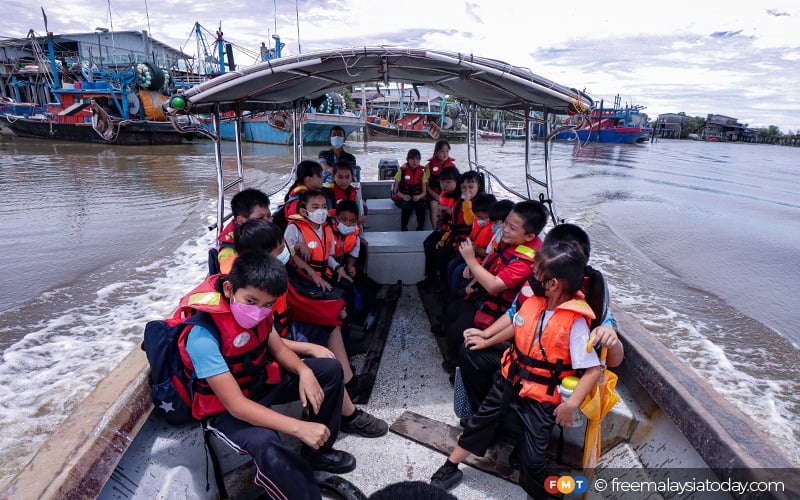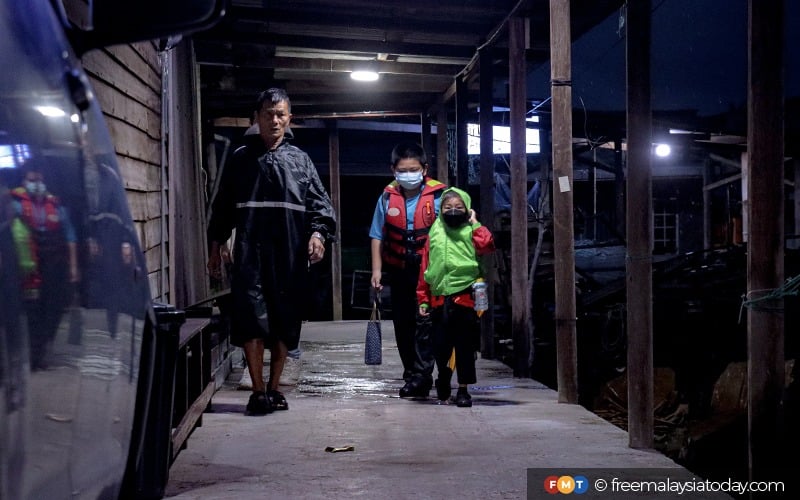
KUALA SELANGOR: In a secluded fishing village in Selangor, bright orange life jackets shimmer in the dark as children walk along creaky wooden slats that lead to the docks, where they will take off on a boat to get to school.
While many living in the city would commute by car or rely on public transport, this is not the case for those who reside in Kampung Bagan Sungai Kajang.
Village head Lim Hock Tiong said students had been taking the boat to and from school every day since the 1970s.
“Kids right now have it good. There wasn’t a designated boat to send students to school back in the day, so they had to wait by the docks for fishermen who were going to work and ask for a ride,” he said.
The fishing village, tucked in the southwest corner of Tanjung Karang, is separated from its nearest primary school, SJK(C) Yit Khwan, by Sungai Tengi, a winding river that flows into the Strait of Malacca.
Lim said driving to school would have taken about half an hour since the main road that cuts across the river is at least an eight-minute car ride away. There are also villagers who do not own a vehicle.

As a result, most parents have opted to send their children to school by boat out of convenience, with the journey taking less than 10 minutes.
“There used to be more than 60 students who would take the boat to school. Presently, we only have 26 students riding the boat. Another small group of students go to school by car because they don’t know how to swim,” Lim said.
Ng Hock Eng, 59, became the designated “school boat captain” in 2006 after the village appealed for a boat from the federal government to ferry students across the river.
Following a 2-minute boat ride, Hock Eng would need to take the children, who are between the ages of 5 and 12, through the back of a seafood restaurant, across a street and over a small bridge before they finally arrive at the entrance of the school.
“There’s no time to rest. I have to make three or four trips to bring (the students) back from school. Sometimes they leave at noon, 1pm and 2pm. They all want to go home at different times,” he said.
As a token of appreciation, the parents pay Hock Eng RM20 every month. Recently, they raised the monthly fees to RM40 after learning that the boatman had to spend most of the money he earned on fuel and repairs for the boat.

“Fuel for the boat is about RM150 a month. If the engine of the boat is damaged, I have to fork out my own money to repair it, which can cost me between RM1,000 and RM2,000,” he said.
Ng Kok Yaw, whose three children take Hock Eng’s boat to school, empathised with the boatman, saying that he understood the difficulties of the job.
“He’s the only person who is willing to take the kids to school by boat. Everyone else is not up for the task. It’s hard work,” he said.
For now, Lim said there are no plans to build a bridge to connect the two sides of the village.
“I requested a bridge from the government about 10 years ago, but the cost was too high and the government couldn’t afford it,” he said.
Meanwhile, the students only have good things to say about the boat rides.
Five-year-old Luna Tee thought taking the boat to school was the coolest thing, and she was envious of her friends who got to do it before she did.
“Taking the boat gets me to school very fast. I’m very happy,” she told FMT.
Luna’s cousin, Tee Huey Yi, six, chimed in to say that she enjoyed looking at the beautiful scenery from the boat every day.
“(The boat ride) is as cool as if you are in a room with an air-con,” she said. - FMT
No comments:
Post a Comment
Note: Only a member of this blog may post a comment.